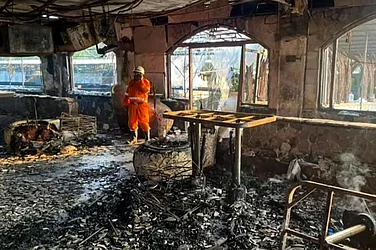One of the most significant impacts of climate change is on our food system. It affects the way we produce as well as consume food. The impact is even more on a predominantly agrarian economy like India, creating ripple effects on the entire food production chain. On Sunday, the mercury level in several states of north India touched 49 degrees Celcius, making it one of the hottest days in recent history. The damage caused to agriculture and food security by the ongoing heatwave is multi-dimensional. It damaged the wheat crop, and affected the food supply, prompting a phenomenal rise in the price of wheat products. The loss to wheat is both qualitative as well as quantitative as besides the low output, the grain is also of poor quality. It should be seen in the light of the fact that food security is as much about the quantity of food, as it is about the nutritional value.
Rising threat to India’s Food Security
The Global Food Policy Report 2022 by the International Food Policy Research Institute has warned that climate change may push many Indians towards hunger by 2030 due to a decline in agricultural production and disruption in the food supply chain.
The report states that globally, around 65 million people are at risk due to climate change-induced hunger, with 17 million people in India facing hunger by 2030, the highest among all countries. The report further notes that although global food production may increase by 60 per cent by 2050, 50 crores of Indians would still be at the risk of going hungry. Of these 50 crores, seven crore people would suffer from hunger due to climate change.
"Higher temperatures, changing precipitation patterns, sea-level rise, and growing frequency and intensity of extreme weather events such as droughts, floods, extreme heat, and cyclones are already reducing agricultural productivity, disrupting food supply chains, and displacing communities," the report noted.
India’s recent ban on wheat export stands as another witness to the spiral effect of the heatwave. A government notification on May 13 stated that India would suspend overseas sales of wheat to manage its food security. The wheat price, already high due to Russia's invasion of Ukraine which is a major exporter of wheat, touched 435 Euros ($453) per tonne, affecting the developing countries the most.
While India’s move has been criticised by the agriculture ministers of G-7 nations, it is an attempt by the government to control the rising domestic prices of wheat due to a poor crop this year.
Significantly, India had a good wheat harvest during all those warmer years in the last decade, and this is the first instance of such a widespread impact on the crop in the last 15 years. The decline in wheat production has pushed its market prices way above the Minimum Supply Price (MSP), prompting farmers to opt for private players instead of the government. Additionally, the central government has already reduced the wheat share given under the Pradhan Mantri Garib Kalyan Anna Yojana to states and Union territories, with Uttar Pradesh, Bihar and Kerala not allotted any wheat under the scheme.
The wheat prices have surged in the last month, increasing the cost of everything from bread to cakes and noodles.
Last week, the Ministry of Agriculture stated that potato production in the current year is estimated to be 53.60 mt, down from 56.17 mt last year. Unseasonal rainfall in November-December last year, along with a countrywide heatwave, affected potato production. A report by Krishi Jagran stated that the wholesale price of common variety potato (Jyoti variety) has increased by nearly 57 per cent this year to Rs 22-24 a kg, up from Rs 14-16 a kg in the same period last year.
In Tamil Nadu, the cost of tomatoes, beans, turnip, carrots and beetroot among other vegetables has also shot up by 20 per cent in the last week.
Facing drought and heatwave, farmers resort to the overuse of fertilizers and pest controls, leading to a rapid acceleration in groundwater depletion, which not only increases their cost of production but also damages the food quality.
**
The largest mangrove forest in the world, Sundarbans, is also facing the damaging impact of climate change. Often called the cyclone capital of India, Sundarbans’s agro-economy has been battered by multiple cyclonic storms in recent years --- Fani (May 2019), Bulbul (November 2019), Amphan (May 2020) and Yaas (May 2021). With saline water entering the lands, while paddy fields become non-fertile for cultivation for some time, some of the farmlands inundated by seawater are still lying fallow, leading to a decline in the production of freshwater fish.
The most affected people are the marginalized sections. According to a report, Science and Culture: Sea Level and Associated Changes in the Sundarbans, nearly 42 per cent population of the island are SC/ST, with most of them engaged in fishing, crab collection or honey collection. The report shows that over the last decade the catch in the Sundarbans has a negative trend along with a decline in the major catch Hilsa in the Hoogly-Malta estuary.
**
Another report by the UN Intergovernmental Panel on Climate Change (IPCC), Climate Change 2022: Impacts, Adaptation and Vulnerability, predicted that India’s high vulnerability and exposure to climate change is going to threaten food security and slow the country’s economic growth, besides impacting health and the overall development process, making poverty reduction even more difficult. India may not be facing an immediate famine, but policymakers have a task cut out.


























